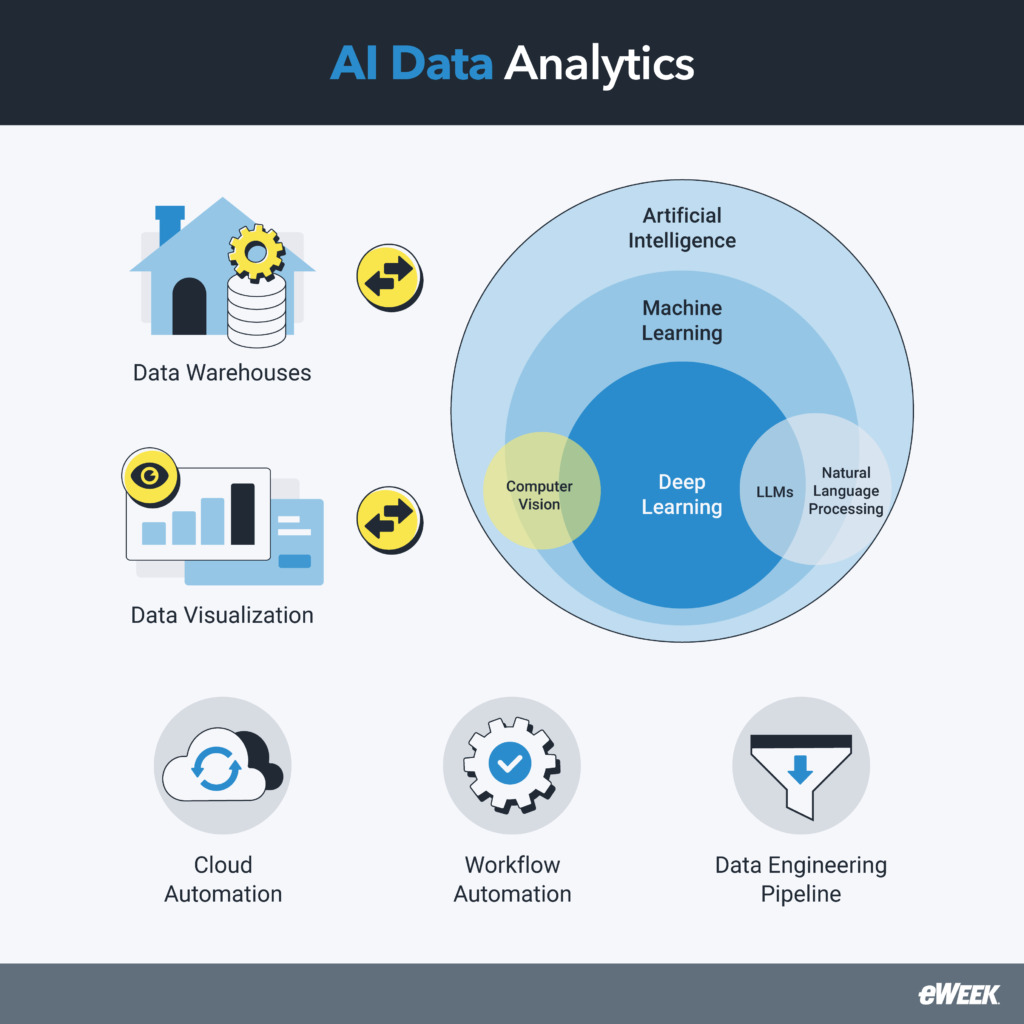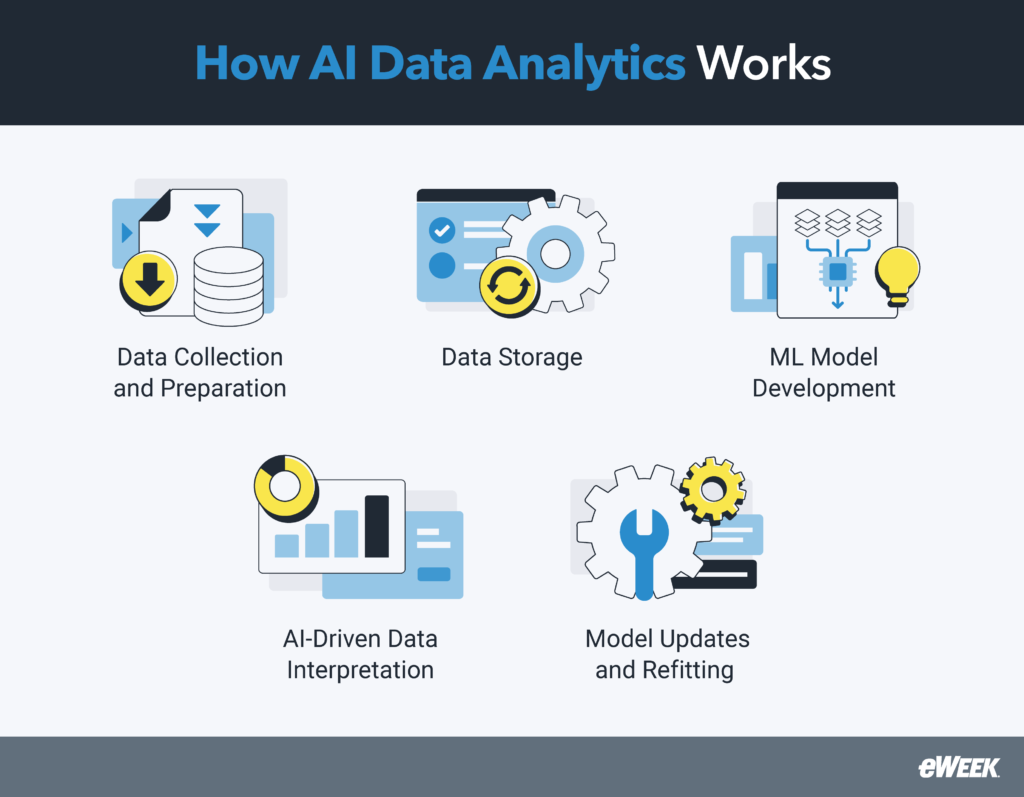One of the main advantages of artificial intelligence (AI) is its ability to rapidly process vast amounts of data, far exceeding human capabilities. However, humans are still instrumental for contextualizing the processed data and gleaning relevant insights for decision-making. AI data analytics simplifies and automates this process for business users, further eliminating manual efforts and reducing the overhead required to go from raw data to actionable intelligence. Here’s what you need to know about the fundamentals of AI data analytics, its key components and how they work, the main applications for the technology, and the leading platforms and tools on the market today.
KEY TAKEAWAYS
- •AI data analytics comprises several interlocking components in an end-to-end, iterative AI/ML workflow. (Jump to Section)
- •Implementing AI data analytics involves finding the right tool, integrating it with existing data workflows, training analysts, and monitoring ongoing performance. (Jump to Section)
- •Top tools for AI data analytics include Databricks, Snowflake, SAS Viya, and Apache Spark. (Jump to Section)
TABLE OF CONTENTS
What is AI Data Analytics?
AI data analytics uses artificial intelligence to analyze large datasets, uncover patterns and trends in these vast volumes of data, and interpret the findings for more accurate business predictions or recommendations. By automatically uncovering insights hidden within deep expanses of data, AI data analytics enables data analysts and strategists to make highly accurate business decisions quickly—with a greatly reduced margin of error.
It brings together an array of AI tools, such as machine learning (ML), deep neural networks, natural language processing (NLP), large language models (LLMs), and computer vision, as well as traditional data analytics tools, such as data warehouses and data visualization platforms. Cloud automation platforms, workflow automation tools, and data engineering pipeline solutions provide underlying functionalities that enable proper AI data analytics.

How AI Data Analytics Works
AI data analytics consists of several interlocking components in an end-to-end, iterative AI/ML workflow. The starting component combines various data sources for creating the ML models—once data is collected in raw form, it must be cleaned and transformed as part of the preparation process. The next set of components involves storing the prepared data in an easy-to-access repository, followed by model development, analysis, and updating.

Applications of AI Data Analytics
AI has become pervasive and continues to shape innovations across multiple sectors. Data analysts in various industries can leverage AI data analytics to enhance their work. Whether detecting credit card fraud in real time, aiding in disease diagnosis, forecasting retail demand, or using propensity modeling for gaming apps, AI data analytics is now a driving force behind a wide range of industry-specific applications.
Real-Time Credit Card Fraud Detection
Credit card fraud is a widespread fraud that impacts financial institutions, businesses, and consumers across the globe. Some common types of credit card fraud include physical card theft, card skimming, and data breaches that result in large swathes of stolen credit card information from online customers. ML models are highly effective for detecting unauthorized transactions and signs of credit card fraud in real time, allowing retailers, financial institutions, and law enforcement agencies to minimize financial losses and apprehend malicious actors.
Disease Diagnosis Assistance
AI data analytics helps physicians, researchers, and healthcare professionals diagnose diseases more accurately. Because it can analyze complex medical data and surface patterns undetectable by humans, AI algorithms enable a high degree of diagnostic accuracy while reducing false positives and human error. By the same token, AI data analytics also enables early disease detection for more timely interventions and treatments.
Demand Forecasting in Retail
Demand forecasting is crucial for sales, retail, manufacturing, and supply chain industries looking to optimize their planning capabilities. By using AI data analytics to predict future demand, organizations can increase operational efficiency and agility by meeting anticipated levels of required materials and inventory ahead of time.
Propensity Modeling for Gaming Apps
Propensity modeling in gaming involves using AI to predict a player’s behavior—for example, their next game move or likely preferences. By applying predictive analytics to the playing experience, game developers can anticipate whether a player will likely make an in-game purchase, click on an advertisement, or upgrade. This enables game companies to create more interactive, engaging game experiences that increase player engagement and monetization.
Sentiment Analysis for Customer Feedback
Companies use AI-powered sentiment analysis to analyze bodies of content—chats, emails, social media comments, and voice conversations, for example—for qualitative determinations. Determining whether messages are positive, negative, or neutral in tone allows businesses to automatically improve their products and services based on customer feedback.
Image and Video Analysis for Enhanced Decision-Making
Many enterprises heavily leverage AI for image and video analysis across various applications, from medical imaging to surveillance, autonomous transportation, and more. Without AI data analytics, many of the security automation and safety controls that consumers rely on would be relegated to humans. For example, social media platforms use AI algorithms to analyze images and videos for inappropriate or harmful content at scale to combat predatory behavior and bolster online safety.
Top 4 Platforms and Tools for AI Data Analytics
The marketplace is filled with powerful AI data analytics tools to meet a range of needs and budgets. We recommend four in particular for their feature sets and capabilities: Snowflake AI Data Cloud, Databricks Data Intelligence Platform, SAS Viya, and Apache Spark.
Snowflake AI Data Cloud
Snowflake started as an enterprise data warehouse solution but has since evolved into a fully managed platform encompassing all components of the AI data analytics workflow. The Snowflake AI Data Cloud also incorporates the Snowflake Marketplace, which effectively opens the platform to thousands of datasets, services, and entire data applications.
Pricing varies depending on the subscription plan (Standard, Enterprise, and Business Critical), ranging from $2 to $4 per credit. The Virtual Private Snowflake plan gives businesses their own separate environment—contact the company for a custom quote.

Databricks Data Intelligence Platform
Like Snowflake, Databricks has evolved from an enterprise data lakehouse into a complete data intelligence platform that includes data warehousing capabilities along with a range of AI data analytics capabilities—extract, transform, load (ETL), SQL, ML, business intelligence (BI), and more.
Databricks offers a pay-as-you-go pricing model dependent upon the features you use, including workflows and streaming, data warehousing, interactive workloads, generative AI, and cross-platform capabilities for governance, management, and security.

SAS Viya
SAS has long focused on the analytics part of the data value chain; however, its Viya offering aims to provide a broader scope of features: in-memory analytics on top of high performance, highly scalable cloud-based infrastructure, AI/ML, change management, and data governance capabilities, to name a few. SAS Viya users can also integrate LLMs and generative AI applications into their data workflows.
SAS Viya pricing starts at $10,000 per year but can range from $1,500 per user for select offerings to millions of dollars for a complete implementation.

Apache Spark
Although free doesn’t always translate to better, the open-source Apache Spark has long delivered a no-cost AI data analytics engine that can compete with the leading commercial solutions on the market. For many data professionals, Spark remains the go-to open source platform for data engineering, data science, and ML applications.

Implementing AI Data Analytics
Successfully implementing AI data analytics at your organization requires managing a lot of moving parts and involves people at many levels of the business, but at a high level, the steps include finding the right tool, integrating it with existing data workflows, training analysts to use it, and monitoring the ongoing performance.
Choosing the Right AI Tools
Data professionals can select from a wide array of AI tools available on the market. Choosing the right AI tooling depends on which solution fits their particular scenario, use case, and environment. For example, organizations handling lots of structured data and looking to seamlessly integrate functionality from popular third-party apps can opt for a solution with an expansive app marketplace like Snowflake or Databricks.
Integrating AI with Existing Data Workflows
When integrating AI with existing data workflows, consider whether the data sources require special preparation, structuring, or cleaning. For training, ML models require high-quality data that is free from formatting errors, inconsistencies, and missing values—for example, columns with “NaN,” “none,” or “-1” as missing values. You should also implement data monitoring mechanisms to continuously check for quality issues and ongoing model validation measures to alert you when your ML models’ predictive capabilities start to degrade over time.
Training Data Analysts on AI Tools
Data analysts are typically proficient in handling and manipulating data, but not with AI/ML tools for training, tuning, and evaluating predictive models. AI data analytics users may require training in the facets of data related to the ML side of affairs, especially model management and monitoring, explainable AI (XAI), and assessing model performance.
Continuous Performance Enhancement
According to a recent study from MIT, Harvard, The University of Monterrey, and Cambridge, 91 percent of ML models degrade over time. In the absence of continuous monitoring and performance enhancements, your AI-powered predictions will degrade and lose accuracy over time. You should always plan on refitting data and retraining your models as a routine activity in your AI data analytics management and maintenance regimen.
Frequently Asked Questions (FAQs)
AI data analytics uses AI to analyze large data sets, uncover patterns and trends in these data volumes, and interpret the findings for more accurate business predictions or recommendations.
AI tools are particularly skilled at analyzing data on a large scale, handling volumes far beyond human capacity. Some examples of free AI tools for analyzing data include Google Data Studio and ChatGPT.
As a data analyst, you can leverage AI to discover patterns hidden deep within your datasets and easily format, customize, and visualize your data sets.
According to Glassdoor figures, AI data analytics and AI data/data science-related professionals can make between $164,000 and $269,000 a year.
Though AI will continue to simplify the data analyst’s job, humans will remain an essential part of an organization’s data-driven initiatives. AI data analytics enhances data analysts’ core capabilities, training, and skill sets rather than replacing them.
AI tools can be used to analyze various types of data, whether in the form of Excel spreadsheets, PDFs, Word documents, or web pages, among others.
Bottom Line: Leveraging AI Data Analytics for Business Success
AI data analytics has become a fixture in today’s enterprise data operations and will continue to pervade new and traditional industries. By enabling organizations to optimize their workflow processes and make better decisions, AI is bringing about new levels of agility and innovation, even as the business playing field becomes more crowded and competitive.
Learn more about other use cases and applications for AI in the workplace to see how it is transforming businesses across industries.